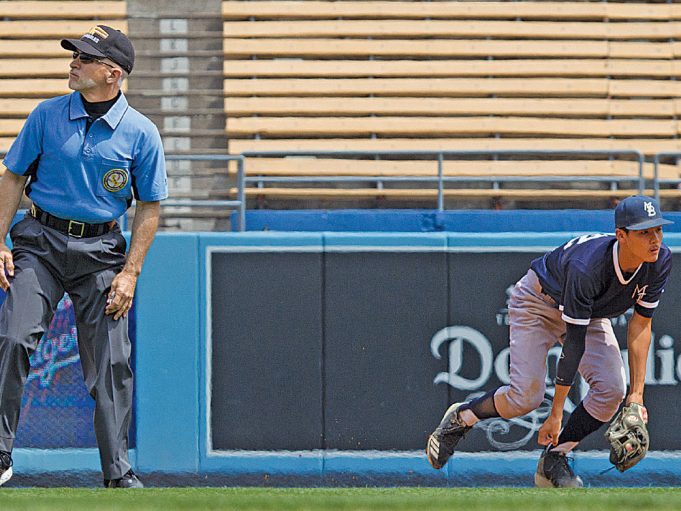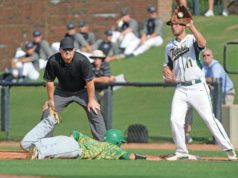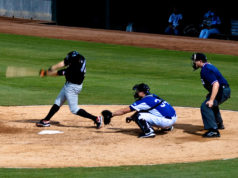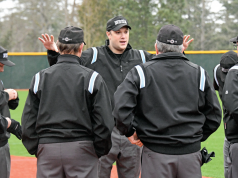No matter what umpiring mechanics are being used in a particular game — whether it’s a single umpire working a youth baseball game or six umpires taking the field for an MLB playoff game — the numbers are not in our favor when it comes to the need to see all possible action on the playing field.
Think about it: There are nine possible players who can be involved in any particular play on defense. There could be anywhere between one and four baserunners. And just for fun, we have the actual baseball often moving at speeds close to 100 mph, whether the result of an incoming pitch, solid contact off the bat or a throw from across the infield or back in from the outfield. Expecting two, four, six or even 12 eyes to be able to see every last detail is basically one impossible ask.
So it’s imperative umpires do nothing during a game that is going to tilt those odds even more in favor of not being able to see something. Because then we are left in the position of having to make a guess — and not even an educated one at that.
Let’s examine a few situations where umpires can get themselves in trouble by taking their eyes away from the action — even if it’s just for a brief moment.
Strike-calling mechanics
There will likely be eternal debate among umpire instructors about which mechanic to use when calling a strike as the plate umpire: the hammer or the point. What typically happens is an umpire decides whichever mechanic simply feels better and looks better for his or her body type.
However, one part of the mechanic that should definitely not be in dispute no matter an umpire’s preference is where the eyes go while it’s happening. While some individual flair is not necessarily a bad thing — especially on a strike-three mechanic — the days of the big sideways step and point popularized by Dutch Rennert or the back-breaking twist more recently employed by Tom Hallion are now always going to be considered a no-no.
The reason? At some point in the mechanic, the eyes move away from the playing action on the field, creating a recipe for disaster.
What if it’s strike three and the catcher fails to cleanly secure the pitch? We need to know how the ball got on the ground. Did he simply drop it? Did the batter interfere via a wayward backswing? And what if that loose ball suddenly gets away from the catcher? Did the batter kick it with his foot? If so, was it done with intent or accidentally?
Another plausible situation: A runner is stealing on the pitch. If we’re looking anywhere but straight ahead, we could easily miss offensive interference by a batter who steps in front of the catcher who is attempting to make a throw. There are few worse feelings than having a coach question why interference was not called on a batter, and you knowing you are unable to provide an honest answer because you didn’t see what actually transpired, courtesy of being too wrapped up in a showy strike-three punch-out mechanic.
Catch/no catch situations
It’s seemingly elemental that knowing whether or not the ball has been caught is a primary job requirement for an umpire. But again, we have a lot of things to keep an eye on, and sometimes the desire to quickly move on to the next facet of play gets us in trouble on this most basic of tasks.
Let’s start with routine fly balls hit into the outfield with runners on base. It’s an understandable tendency that an umpire would like to shift the focus from that proverbial “can of corn” to subsequent playing action such as runners tagging up and trying to advance as quickly as possible. The problem is when that can of corn suddenly ends up spilled all over the supermarket aisle.
Did the outfielder actually complete the catch and drop the ball during his voluntary release of starting his throw back to the infield? Or did he never complete the act of making a catch by rule? Only a split-second may differentiate between the two, but you may not have the information to rule accurately if that’s the moment in time you have taken your eyes off the play.
Double-play situations are also a prime time for this type of problem. Let’s say you’re working two-umpire mechanics and the defense is trying to turn a 6-4-3 double play. As the base umpire in the middle of the infield, you need to be aware of a successful turn at second base that includes the second baseman catching the ball and stepping on the bag, while also keeping an initial look on any illegal activity by R1 coming into the base. You then must follow the second throw to first base and try to have a good look at what is often a bang-bang play. That’s a lot of information for one set of eyes to digest.
It’s made even more troubling, however, if you miss any one part of the play to move on to another. All umpires have faced the situation where, convinced of the first out, they turn their head too quickly to see the back end of the play, only to find out the baseball is now lying on the ground at the second baseman’s feet. Did he complete the catch of the first throw by the shortstop and then drop the ball on the transfer? Did he never actually complete the catch? It’s a play that can quickly put a knot in your stomach when you realize you didn’t actually see it and can’t honestly rule on it.
Errant throws
Lucky is the umpire who has never taken a thrown baseball off the melon. However, your odds of avoiding such ignominy are greatly increased if you can just remember to always keep your eye on the baseball and not assume a player is going to have true aim.
A perfect example is the ball hit deep in the hole at shortstop with an umpire in the “C” position. Once the ball has been fielded, many umpires have turned their back on the baseball on this play in anticipation of the long throw to first base, setting up two potential problems.
The first is there is no guarantee that shortstop is going to have the accuracy to avoid pegging you. How many times has one of these throws whizzed right past your ear, leaving you with the realization that had you taken one false step in your set-up to see the play at first base, you would have instead been lying on the ground seeing stars?
Or, how about this embarrassing wrinkle: The shortstop never actually throws the baseball. If you’re in “C,” that means there is a runner on second or third base. Ever experienced the situation where the ball is hit deep in the hole, you turn toward first and crouch down to give the shortstop plenty of room to make his throw, and then you realize there isn’t one, because instead a play is being made on that lead runner, and you never saw it? That’s a fun one to try to explain to an exasperated coach.
The bottom line in all of these situations, and the many, many more that we haven’t even dug into? Keep your eyes on the baseball. If you can see it, you can at least sell it. You may not have everyone in agreement with your judgment, but at least you will be able to say that you had all the necessary information to make your ruling.
What's Your Call? Leave a Comment:
Note: This article is archival in nature. Rules, interpretations, mechanics, philosophies and other information may or may not be correct for the current year.
This article is the copyright of ©Referee Enterprises, Inc., and may not be republished in whole or in part online, in print or in any capacity without expressed written permission from Referee. The article is made available for educational use by individuals.


















